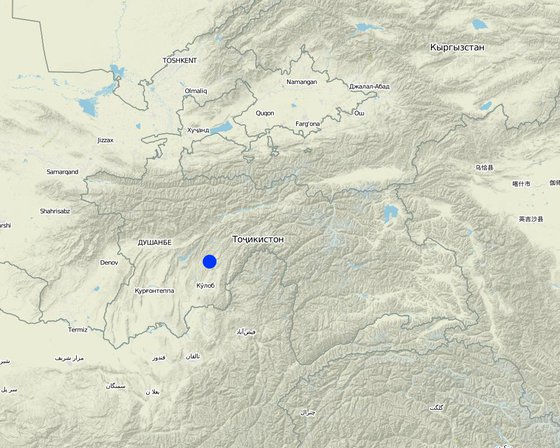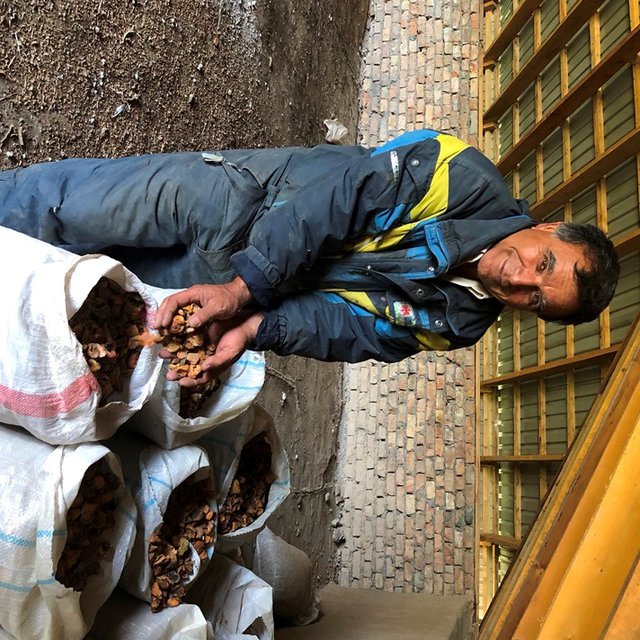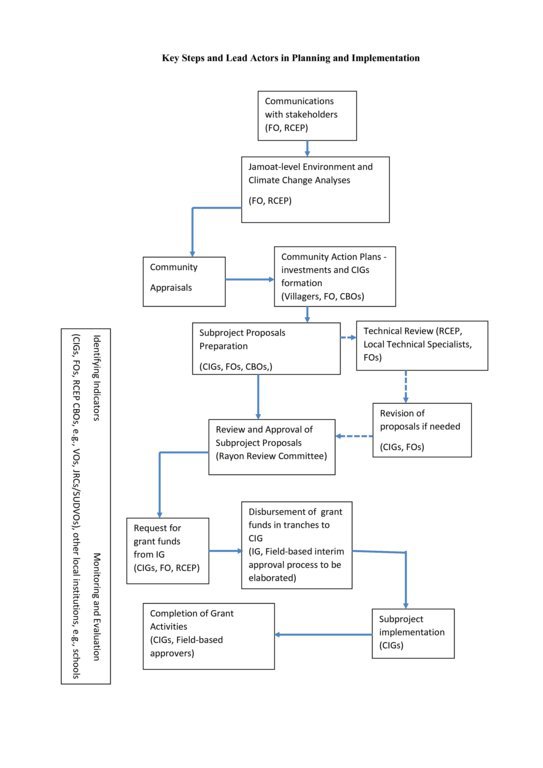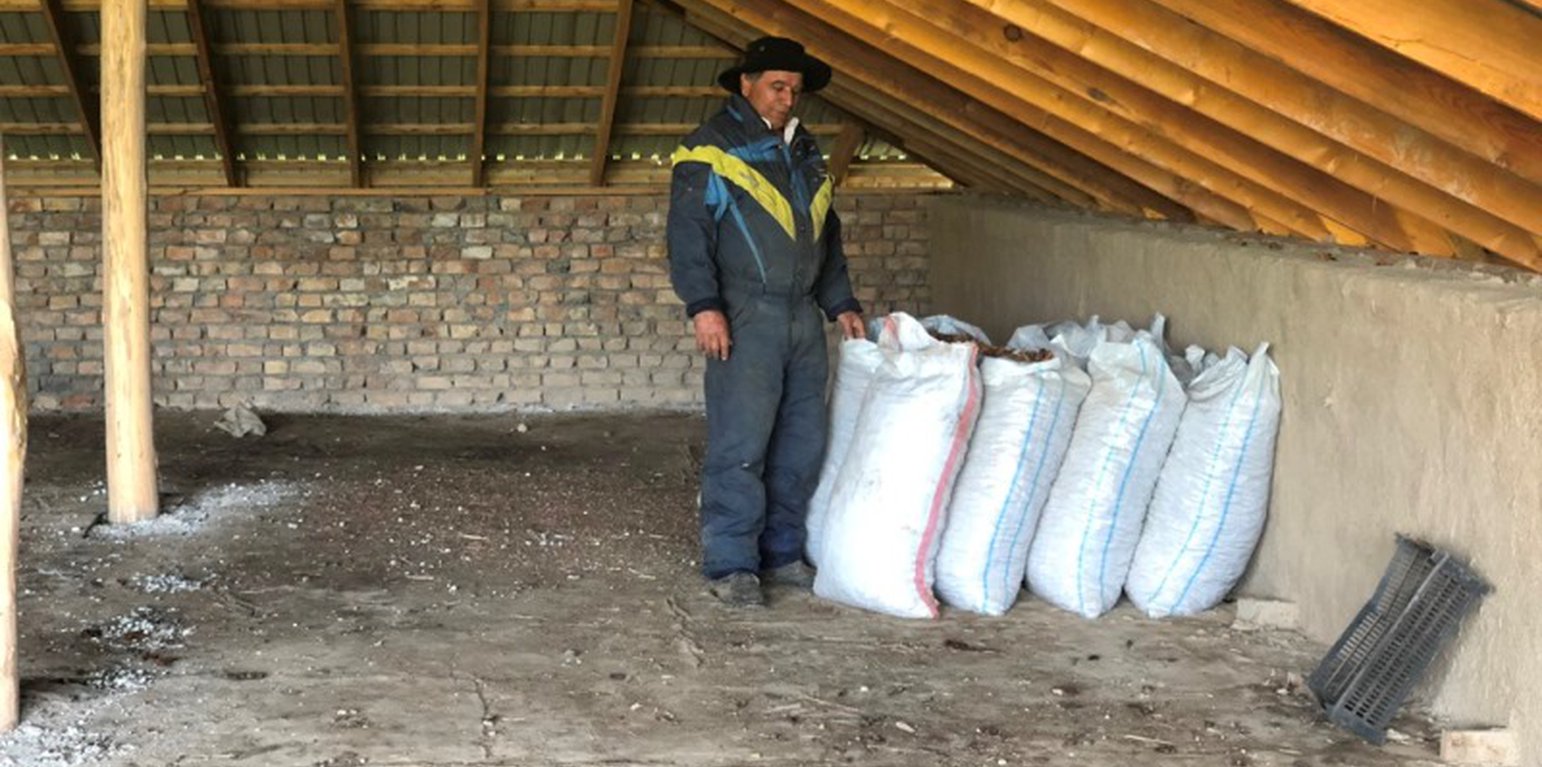Saving harvest of the orchards through drying
(ຕາຈິກິສະຕານ)
Пешгирии талафоти мева таввасути қоқкунӣ
ຄຳອະທິບາຍ
Gardeners in different ways store apples, pears, pomegranates, grapes and nuts for winter, but the main part of the harvest used for the animals. Proposed approach help land users to save all the harvest using drying methods.
People usually used fresh fruits and store it in a different way for the winter. Therefore, to preserve freshness and juiciness, apples and granates reserved them in jars.There are many opportunities for drying fruits in Safedshahrak village of Lohuti jamoat. The village has more than 10 hectares of orchards. The village is located far from the district center at a distance of 18 km, in the north-east part of the district and at an altitude of 1300 m. The climate is humid and with abundant rainfall. Local people are mainly engaged in growing potatoes, gardening and livestock breeding. Industrial enterprises do not function in the district. A small number of women study at Medical College and a vocational technical school or attend a special high and secondary schools in Dushanbe to get any skills. However, working places are only available in the central district hospital and general education schools for 5-6% of the total number of qualified women.
The project provides small-scale grants at the village level for groups of households to implement rural production and land management investments, as well as related small-scale infrastructure investments.Villages will prioritize investments based on a fixed budget for each type of rural investment, determined by the number of households
The CIG established in Safedshahrak village, which consisted of 25 members, and they recognize their work on drying fruits as an advantage in the first place. With the support of the project, the CIG was purchased and installed tools and equipment for drying fruit, and put production into operation.
Abdukodir Gozaev, a head of CIG, made all preparations for the construction of a warehouse for drying fruits, organized work on harvesting and drying fruit according to the plan. As a result, the rural people collected 60 tons of fresh fruit, which were dried. There are 3.5 tons of dried apples, 3.5 tons of cherries, 1 ton of rose hips and 0.5 tons of plums in the group's warehouse. Collected products were sold, and the sale profit was TJS 21950 (2,488$). The CIG head paid to the population from the funds received after the sale. In the future, he intends to prepare special boxes and sell them with packed dried fruit. This type of activity will give the opportunity to adapt their products to market requirements
ສະຖານທີ່

ສະຖານທີ່: Jamoat Lohuti, Safedshahrak village, Kulob Region, Khovaling District, ຕາຈິກິສະຕານ
ການຄັດເລືອກພື້ນທີ່ ທີ່ອີງໃສ່ຂໍ້ມູນທາງພູມີສາດ
ວັນທີເລີ່ມຕົ້ນ: 2016
ປີຂອງການສິ້ນສຸດ: 2017
ປະເພດຂອງແນວທາງ
-
ພື້ນເມືອງ / ທ້ອງຖີ່ນ
-
ການລິເລີ່ມ ພາຍໃນປະເທດ ທີ່ຜ່ານມາ / ນະວັດຕະກໍາ
-
ພາຍໃຕ້ໂຄງການ / ແຜນງານ

The head of CIG with their production (Kamolidin Abdulloev)
ເປົ້າໝາຍຂອງແນວທາງ ແລະ ການປົກປັກຮັກສາສິ່ງແວດລ້ອມ
ເປົ້າໝາຍ / ຈຸດປະສົງຫຼັກໃນການຈັດຕັ້ງປະຕິບັດແນວທາງ
Supporting gardeners to improve the management of the orchards and to save their harvest using drying fruit approach, by this way to raise the household income
ເງື່ອນໄຂທີ່ສະໜັບສະໜູນໃຫ້ການຈັດຕັ້ງປະຕິບັດເຕັກໂນໂລຢີ ບົນພື້ນຖານແນວທາງ
-
ສັງຄົມ / ວັດທະນະທໍາ / ມາດຕະຖານ ແລະ ຄຸນຄ່າທາງສາສະໜາ: None
-
ມີຄວາມສາມາດ / ເຂັ້າເຖິງຊັບພະຍາກອນດ້ານການເງິນ ແລະ ການບໍລິການ: None
-
ການກໍ່ຕັ້ງສະຖາບັນ: None
ເງື່ອນໄຂທີ່ເຊື່ອງຊ້ອນໃຫ້ການຈັດຕັ້ງປະຕິບັດເຕັກໂນໂລຢີ ບົນພື້ນຖານແນວທາງ
-
ສັງຄົມ / ວັດທະນະທໍາ / ມາດຕະຖານ ແລະ ຄຸນຄ່າທາງສາສະໜາ: People usually used fresh fruits or stored apples, pears, grapes and nuts for winter only as the juice and did not drying them. Duirng the season gardenners lost thousands tons of the fruits that were the main part of their harvest
As the result of the project there were appeared an opportunity to save all the harvest from their orchards and additionaly have income from that
-
ມີຄວາມສາມາດ / ເຂັ້າເຖິງຊັບພະຍາກອນດ້ານການເງິນ ແລະ ການບໍລິການ: Gardeners used only fresh fruits and did not use the main part of their harvest as a result, the rural people collected 60 tons of fresh fruit, which were dried. There are 3.5 tons of dried apples, 3.5 tons of cherries, 1 ton of rose hips and 0.5 tons of plums in the group's warehouse. Collected products were sold and have a good profit. The CIG head paid to the CIG Members (local Land Users) from the funds received after the sale. In the future, he intends to prepare special boxes and sell them with packed dried fruit. This type of activity will give the opportunity to adapt their products to market requirements.
-
ການກໍ່ຕັ້ງສະຖາບັນ: As the result of the project established the Common Interest Group that will manage and maintain the approach in future
-
ຄວາມຮູ້ກ່ຽວກັບການຄຸ້ມຄອງ ທີ່ດິນແບບຍືນຍົງ, ການເຂົ້າເຖິງການສະໜັບສະໜູນ ທາງດ້ານວິຊາການ: Lack of knowledge on SLM approaches and technologies There was organised different type of SLM relative trainings on behalf of the project during the approach implementation
ການມີສ່ວນຮ່ວມ ແລະ ບົດບາດຂອງພາກສ່ວນທີ່ກ່ຽວຂ້ອງທີ່ມີສ່ວນຮ່ວມ
ພາລະບົດບາດຂອງພາກສ່ວນທີ່ກ່ຽວຂ້ອງ ທີ່ມີສ່ວນຮ່ວມໃນການຈັດຕັ້ງປະຕິບັດແນວທາງ
| ແມ່ນໃຜ / ພາກສ່ວນໃດ ທີ່ເປັນເຈົ້າການ ໃນການຈັດຕັ້ງປະຕິບັດ ວິທີການ? |
ລະບຸ ພາກສ່ວນທີ່ກ່ຽວຂ້ອງ |
ພັນລະນາ ບົດບາດ ໜ້າທີ່ ຂອງພາກສ່ວນທີ່ກ່ຽວຂ້ອງ |
| ຜູ້ນໍາໃຊ້ດິນໃນທ້ອງຖິ່ນ / ຊຸມຊົນທ້ອງຖິ່ນ |
Gardeners (CIG Members) |
Local land users prioritized investments based on a fixed budget for each type of rural investment determined by the number of households. Within a plan of action, participants decided on the allocation of investments to groups of households using rules that limit the funding for any one household. |
| ຜູ້ຊ່ຽວຊານ ການນຄຸ້ມຄອງ ທີ່ດິນແບບຍືນຍົງ / ທີ່ປຶກສາດ້ານກະສິກໍາ |
Reprezentatives from the project parners and government institutions |
Reprezentaives from the facilitating organisations and professors (as TOT trainers) from the Institutions and academies involved during the trainings |
| ອໍານາດ ການປົກຄອງທ້ອງຖິ່ນ |
Hukumat and jamoat reprezentatives |
Jamoat representatives were involved in Participatory Rural Appraisal (PRA) that was used as the main pre-assessment mechanism to analyze the socio-economic and environmental situation in the selected pilots, The RRC(Rayon Review Committee) will consider the combination of proposed sub-projects within the overall context of the rayon and project. The committee will review and accept proposals that meet project guidelines and provide clearance to the IG for the release of project funding to the accounts of relevant CIGs. |
ການລວບລວມເອົາຜູ້ນໍາໃຊ້ທີ່ດິນໃນທ້ອງຖິ່ນ/ຊຸມຊົນທ້ອງຖິ່ນ ໃນການຈັດຕັ້ງປະຕິບັດແນວທາງ ແຕ່ລະໄລຍະ
ບໍ່ມີ
ການບໍ່ປະຕິບັດ
ການຊ່ວຍເຫຼືອຈາກພາຍນອກ
ການຮ່ວມມື
ການນໍາໃໍຊ້ເອງ
ການວາງແຜນ
Project beneficiaries (CIG Members) interviewed and consulted during the social assessment conducted in the project design process which then influenced project approaches.
ການປະຕິບັດ
During the Participatory and Community Action Planning Villagers (CIG Members) made grant allocation decisions. After the supporting CIGs proposals, they had managed grant funds and purchased needed materials and products individually
ຕິດຕາມກວດກາ / ການປະເມີນຜົນ
active participation of the local land users during the monitoring process
ແຜ່ນວາດສະແດງ
Step by step implementation and key actors in the process

ຜູ້ຂຽນ: ELMARL POM
ການຕັດສິນໃຈໃນການເລືອກເຕັກໂນໂລຢີ ການຄຸ້ມຄອງທີ່ດິນແບບຍືນຍົງ
ການຕັດສິນໃຈໂດຍ
-
ຜູ້ນໍາໃຊ້ດິນຜູ້ດຽວ (ການລິເລີ່ມດ້ວຍຕົນເອງ)
-
ຜູ້ນໍາໃຊ້ທີ່ດິນຫຼັກ, ການສະໜັບສະໜູນ ໂດຍຜູ້ຊ່ຽວຊານ ການນໍາໃຊ້ທີ່ດິນແບບຍືນຍົງ
-
ພາກສ່ວນກ່ຽວຂ້ອງທັງໝົດ, ເປັນສ່ວນໜຶ່ງ ຂອງວິທີທາງແບບມີສ່ວນຮ່ວມ
-
ຜູ້ຊ່ຽວຊານ ຫຼັກດ້ານການຄຸ້ມຄອງ ທີ່ດິນແບບຍືນຍົງ, ມີການຕິດຕາມປຶກສາຫາລືກັບຜູ້ນໍາໃຊ້ທີ່ດິນ
-
ຊຽ່ວຊານ ສະເພາະດ້ານການຄຸ້ມຄອງ ດິນແບບຍືນຍົງຜູ້ດຽວ
-
ນັກການເມືອງ / ຜູ້ນໍາ
ການຕັດສິນໃຈບົນພື້ນຖານ
-
ປະເມີນເອກກະສານ ຄວາມຮູ້ກ່ຽວກັບ ການຄຸ້ມຄອງ ທີ່ດິນແບບຍືນຍົງ (ຫຼັກຖານທີ່ຊ່ວຍໃນການຕັດສິນໃຈ)
-
ຜົນທີ່ໄດ້ຮັບ ຈາກການຄົ້ນຄວ້າ
-
ປະສົບການສ່ວນບຸກຄົນ ແລະ ຄວາມຄິດເຫັນ (ທີ່ບໍ່ເປັນເອກກະສານ)
-
Project initial phases
ການສະໜັບສະໜູນເຕັກໂນໂລຢີ, ການສ້າງຄວາມອາດສາມາດ ແລະ ການຄຸ້ມຄອງຄວາມຮູ້
ກິດຈະກຳ ດັ່ງລຸ່ມນີ້ ແມ່ນເປັນພາກໜຶ່ງຂອງແນວທາງ
-
ການສ້າງຄວາມສາມາດ / ການຝຶກອົບຮົມ
-
ການບໍລິການໃຫ້ຄໍາປຶກສາ
-
ສະຖາບັນການສ້າງຄວາມເຂັ້ມແຂງ (ການພັດທະນາອົງການຈັດຕັ້ງ)
-
ຕິດຕາມກວດກາ ແລະ ປະເມີນຜົນ
-
ການຄົ້ນຄວ້າ
ການສ້າງຄວາມອາດສາມາດ / ຝຶກອົບຮົມ
ໄດ້ສະໜັບສະໜູນຝຶກອົບຮົມໃຫ້ແກ່ພາກສ່ວນກ່ຽວຂ້ອງດັ່ງລຸ່ມນີ້
-
ຜູ້ນໍາໃຊ້ດິນ
-
ພະນັກງານພາກສະໜາມ / ທີ່ປຶກສາ
ຮູບແບບການຝຶກອົບຮົມ
-
ການເຮັດຕົວຈິງ
-
ຕົວຕໍ່ຕົວ
-
ເນື້ອທີ່ສວນທົດລອງ
-
ກອງປະຊຸມ
-
ຫຼັກສູດ
ກວມເອົາຫົວຂໍ້
Financial management, reporting, subproject/approach management and technical, SLM reletive trainings
ການບໍລິການທາງດ້ານການໃຫ້ຄໍາປຶກສາ
ໄດ້ຮັບການບໍລິການທາງດ້ານການໃຫ້ຄໍາປຶກສາ
-
ໃນພື້ນທີ່ຂອງຜູ້ນໍາໃຊ້ດິນ
-
ສູນຄົ້ນຄວ້າ
Jamoat (agronomist, ecologist and other specialists) advise CIG Members
ຄວາມເຂັ້ມແຂງຂອງສະຖາບັນ
ສະຖາບັນ ໄດ້ຮັບການສ້າງຄວາມເຂັ້ມແຂງ
-
ບໍ່ມີ
-
ມີ, ໜ້ອຍໜຶ່ງ
-
ມີ, ພໍສົມຄວນ
-
ມີ, ຫຼາຍ
ໃນລະດັບດັ່ງລຸ່ມນີ້
-
ທ້ອງຖິ່ນ
-
ລະດັບພາກພື້ນ
-
ແຫ່ງຊາດ
ອະທິບາຍສະຖາບັນ, ພາລະບົດບາດແລະຄວາມຮັບຜິດຊອບ, ສະມາຊິກ, ແລະອື່ນໆ.
The Common Interest Groups formed in the villages on behalf households and enhanced their knowledge. And the project provides small-scale grants at the village level for groups of households (CIG) to implement rural production and land management investments, as well as related small-scale infrastructure investments. Villages will prioritize investments based on a fixed budget for each type of rural investment, determined by the number of households.
ຮູບແບບການສະໜັບສະໜູນ
-
ທາງດ້ານການເງິນ
-
ການສ້າງຄວາມອາດສາມາດ / ການຝຶກອົບຮົມ
-
ອຸປະກອນ
ລາຍລະອຽດເພີ່ມເຕີມ
Project-financed grants to CIGs for each investment under categories of rural production and land management investments, as well as related small-scale infrastructure investments that will not exceed US$7,000 and will require a match of 25% in beneficiary contributions which may be in cash or in-kind
ການຕິດຕາມ ແລະ ປະເມີນຜົນ
environmental aspects, management of the investments, and other social and economic issues
ການສະໜັບສະໜູນທາງດ້ານການເງິນ ແລະ ອຸປະກອນຈາກພາຍນອກ
ງົບປະມານປະຈຳປີ ໃນກິດຈະກຳ ການຄຸ້ມຄອງທີ່ດິນແບບຍືນຍົງ ທີ່ເປັນສະກຸນເງິນໂດລາ
-
< 2,000
-
2,000-10,000
-
10,000-100,000
-
100,000-1,000,000
-
> 1,000,000
Precise annual budget: n.a.
GEF/PPCR through WB
ການບໍລິການ ຫຼື ສິ່ງກະຕຸກຊຸກຍູ້ ດັ່ງລຸ່ມນີ້ ແມ່ນໄດ້ສະໜອງໂດຍຜູ້ນຳໃຊ້ທີ່ດິນເອງ
-
ການສະໜັບສະໜູນ ທາງດ້ານການເງິນ / ອຸປະກອນ ສະໜອງໃຫ້ແກ່ຜູ້ນໍາທີ່ດິນ
-
ຫຼຸດປັດໃຈນໍາເຂົ້າ
-
ສິນເຊື່ອ
-
ສິ່ງຈູງໃຈ ຫຼື ເຄື່ອງມືອື່ນໆ
ເງິນສະໜັບສະໜູນອຸປະກອນ / ສະໜອງໃຫ້ຜູ້ຊົມໃຊ້ທີ່ດິນ
The project financed investments in three categories that are expected to improve household assets and sustainable land management, and build climate resilience,
The CIGs prepared proposals for investments that included basic data on beneficiaries and funding requirements, the objectives and the issue/opportunity that is being addressed, description of the investment and activities (including a work plan and budget), summary of environmental, economic and social feasibility and sustainability measures, and a brief monitoring and evaluation plan.
Project financed grants to the CIGs that not exceed US$7,000 and will require a match of 25% in beneficiary contributions which may be in cash or in-kind. The grants disbursed in tranches directly to beneficiaries or groups to their own bank account
ສີ່ງກະຕຸກຊຸກຍູ້ອື່ນໆ
Study tours, competition farmer to farmer
ການວິເຄາະຜົນກະທົບ ແລະ ສະຫຼຸບລວມ
ຜົນກະທົບຂອງການນໍາໃຊ້ແນວທາງ
ບໍ່
ມີ, ໜ້ອຍໜຶ່ງ
ມີ, ພໍສົມຄວນ
ມີ, ຫຼາຍ
ວິທີທາງ ຊ່ວຍຊຸກຍູ້ ຜູ້ນຳໃຊ້ທີ່ດິນທ້ອງຖີ່ນ, ໃນການປັບປຸງ ການມີສ່ວນຮ່ວມ ຂອງຜູ້ທີ່ກ່ຽວຂ້ອງ ບໍ່?
As a result, the rural people collected 60 tons of fresh fruit, which were dried. There are 3.5 tons of dried apples, 3.5 tons of cherries, 1 ton of rose hips and 0.5 tons of plums in the group's warehouse. Collected products were sold, in the local market. Local land users paid to their members from the funds received after the sale.
ການນໍາໃຊ້ ວິທີທາງ ສາມາດປັບປຸງຄວາມຮູ້ ແລະ ຄວາມສາມາດຂອງຜູ້ນໍາໃຊ້ທີ່ດິນ ໃນການປະຕິບັດ ການຄຸ້ມຄອງ ທີ່ດິນແບບຍືດຍົງໄດ້ບໍ່?
A big bunch of the training and meetings had been organized with the CIG (local land users) that will give them an opportunity to manage and maintain on hand approach
ສິ່ງກະຕຸກຊຸກຍູ້ໃຫ້ຜູ້ນໍາໃຊ້ທີ່ດິນ ໃນການປະຕິບັດການຄຸ້ມຄອງທີ່ດິນແບບຍືນຍົງ
-
ການຜະລິດເພີ່ມຂຶ້ນ
-
ກໍາໄລເພີ່ມຂຶ້ນ (ຄວາມສາມາດ), ການປັບປຸງຄ່າໃຊ້ຈ່າຍ, ຜົນປະໂຫຍດ, ອັດຕາສ່ວນ
-
ຫຼຸດຜ່ອນດິນເຊື່ອມໂຊມ
-
ຫຼຸດຜ່ອນຄວາມສ່ຽງຂອງໄພພິບັດ
-
ການຫຼຸດຜ່ອນພາລະວຽກ
-
ການຊໍາລະເງິນ / ເງິນອຸດໜູນ
-
ກົດລະບຽບແລະລະບຽບການ (ລະອຽດ) / ການບັງຄັບໃຊ້
-
ກຽດສັກສີ, ຄວາມກົດດັນທາງສັງຄົມ / ການຕິດຕໍ່ກັນທາງສັງຄົມ
-
ລວມເຂົ້ານໍາກັນກັບການເຄື່ອນໄຫວ / ໂຄງການ / ກຸ່ມ / ເຄືອຂ່າຍ
-
ຄວາມຮັບຮູ້ ທາງສີ່ງແວດລ້ອມ
-
ພາສີ ແລະ ຄວາມເຊື່ອຖື, ສົມບັດສິນທໍາ
-
ການປັບປຸງ ຄວາມຮູ້ ແລະ ຄວາມສາມາດ ຂອງການຄຸ້ມຄອງ ທີ່ດິນແບບຍືນຍົງ
-
ການປັບປຸງຄວາມງົດງາມ
-
ການຫຼຸດຜ່ອນຂໍ້ຂັດແຍ່ງ
ຄວາມຍືນຍົງຂອງການຈັດຕັ້ງປະຕິບັດກິດຈະກໍາຂອງແນວທາງ
ຜູ້ນໍາໃຊ້ທີ່ດິນ ສາມາດຈັດຕັ້ງປະຕິບັດຕາມແນວທາງໄດ້ເອງບໍ່ (ໂດຍປາດສະຈາກການສະໜັບສະໜູນຈາກພາກສ່ວນພາຍນອກ)?
The local land user from the beginning did all the activities individually after the training that was provided by the project. made grant allocation decisions, also CIGs managed grant funds and bought inputs. Maintaining actions are in place
ບົດສະຫຼຸບ ແລະ ບົດຮຽນທີ່ໄດ້ຮັບ
ຄວາມເຂັ້ມແຂງ: ທັດສະນະມູມມອງ ຂອງຜູ້ນໍາໃຊ້ທີ່ດິນ
-
The head of CIG is the specialist and knows all the details of the activity that help them better manage and maitain an approach
-
The building and the local materials that was used during the project belonged to the CIG members and it gives them opportunity to implement such project
ຄວາມເຂັ້ມແຂງ: ທັດສະນະມຸມມອງ ຂອງຜູ້ປ້ອນຂໍ້ມູນເອງ
-
Being in a group(CIG), gives opportunity to do desicions together and expanding approach in the plan
-
Capacity building events that was organised during the approach, new technologies, new knowledges and so on
-
Good cooperation with the jamoat
ຈຸດອ່ອນ / ຂໍ້ເສຍ / ຄວາມສ່ຽງ: ທັດສະນະມູມມອງ ຂອງຜູ້ນໍາໃຊ້ທີ່ດິນວິທີການແກ້ໄຂແນວໃດ
ຈຸດອ່ອນ / ຂໍ້ເສຍ / ຄວາມສ່ຽງ: ທັດສະນະມຸມມອງ ຂອງຜູ້ປ້ອນຂໍ້ມູນເອງວິທີການແກ້ໄຂແນວໃດ
-
Market, value chance, preparation of the business plans and other reletive knowledges they need
Other coming projects or local hukumat needs to support them
ເອກກະສານອ້າງອີງ
ວັນທີຂອງການປະຕິບັດ: July 6, 2018
ປັບປຸງລ່າສຸດ: July 29, 2018
ບຸກຄົນທີ່ສໍາຄັນ
-
Murod Ergashev (soil_m@rambler.ru) - ຜູ້ຊ່ຽວຊານ ດ້ານການຄຸ້ມຄອງ ທີ່ດິນແບບຍືນຍົງ
ການບັນຍາຍລາຍລະອຽດ ໃນຖານຂໍ້ມູນ ຂອງ WOCAT
ຂໍ້ມູນການເຊື່ອມໂຍງຂໍ້ມູນການຄຸ້ມຄອງການນໍາໃຊ້ດິນແບບຍືນຍົງ
ເອກກະສານ ແມ່ນໄດ້ອໍານວຍຄວາມສະດວກໂດຍ
ສະຖາບັນ
- Committee for Environment Protection of Tajikistan (Committee for Environment Protection of Tajikistan) - ຕາຈິກິສະຕານ
ໂຄງການ
- Environmental Land Management and Rural Livelihoods (ELMAR)
ການອ້າງອີງທີ່ສໍາຄັນ
-
ELMARL Annual Report 2017:
ເຊື່ອມໂຍງກັບ ຂໍ້ມູນຕ່າງໆ ທີ່ກ່ຽວຂ້ອງທີ່ມີ






